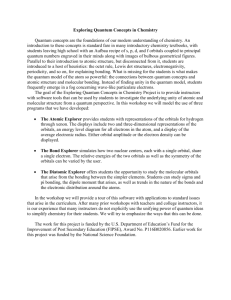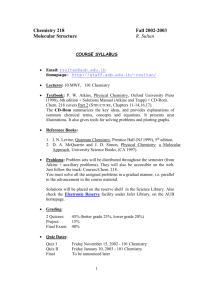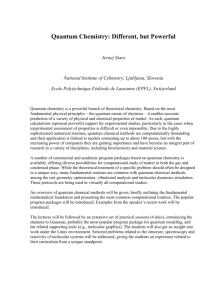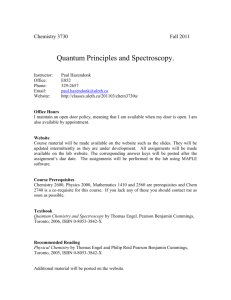Words to the reader about how to use this textbook
advertisement
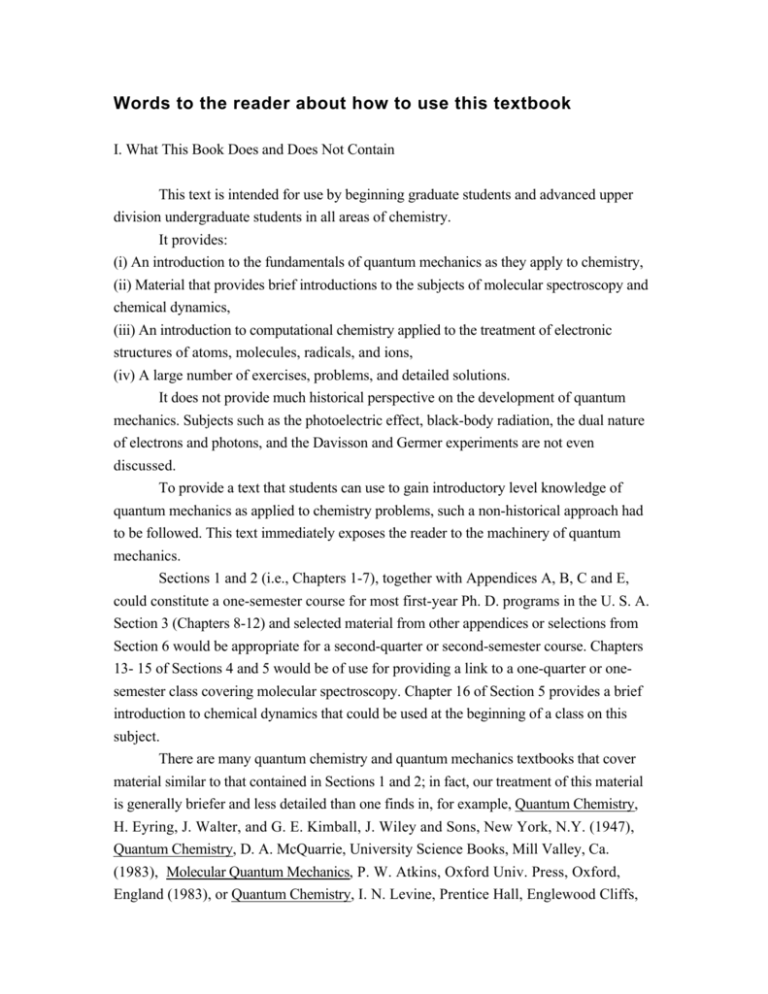
Words to the reader about how to use this textbook I. What This Book Does and Does Not Contain This text is intended for use by beginning graduate students and advanced upper division undergraduate students in all areas of chemistry. It provides: (i) An introduction to the fundamentals of quantum mechanics as they apply to chemistry, (ii) Material that provides brief introductions to the subjects of molecular spectroscopy and chemical dynamics, (iii) An introduction to computational chemistry applied to the treatment of electronic structures of atoms, molecules, radicals, and ions, (iv) A large number of exercises, problems, and detailed solutions. It does not provide much historical perspective on the development of quantum mechanics. Subjects such as the photoelectric effect, black-body radiation, the dual nature of electrons and photons, and the Davisson and Germer experiments are not even discussed. To provide a text that students can use to gain introductory level knowledge of quantum mechanics as applied to chemistry problems, such a non-historical approach had to be followed. This text immediately exposes the reader to the machinery of quantum mechanics. Sections 1 and 2 (i.e., Chapters 1-7), together with Appendices A, B, C and E, could constitute a one-semester course for most first-year Ph. D. programs in the U. S. A. Section 3 (Chapters 8-12) and selected material from other appendices or selections from Section 6 would be appropriate for a second-quarter or second-semester course. Chapters 13- 15 of Sections 4 and 5 would be of use for providing a link to a one-quarter or onesemester class covering molecular spectroscopy. Chapter 16 of Section 5 provides a brief introduction to chemical dynamics that could be used at the beginning of a class on this subject. There are many quantum chemistry and quantum mechanics textbooks that cover material similar to that contained in Sections 1 and 2; in fact, our treatment of this material is generally briefer and less detailed than one finds in, for example, Quantum Chemistry, H. Eyring, J. Walter, and G. E. Kimball, J. Wiley and Sons, New York, N.Y. (1947), Quantum Chemistry, D. A. McQuarrie, University Science Books, Mill Valley, Ca. (1983), Molecular Quantum Mechanics, P. W. Atkins, Oxford Univ. Press, Oxford, England (1983), or Quantum Chemistry, I. N. Levine, Prentice Hall, Englewood Cliffs, N. J. (1991), Depending on the backgrounds of the students, our coverage may have to be supplemented in these first two Sections. By covering this introductory material in less detail, we are able, within the confines of a text that can be used for a one-year or a two-quarter course, to introduce the student to the more modern subjects treated in Sections 3, 5, and 6. Our coverage of modern quantum chemistry methodology is not as detailed as that found in Modern Quantum Chemistry, A. Szabo and N. S. Ostlund, Mc Graw-Hill, New York (1989), which contains little or none of the introductory material of our Sections 1 and 2. By combining both introductory and modern up-to-date quantum chemistry material in a single book designed to serve as a text for one-quarter, one-semester, two-quarter, or one-year classes for first-year graduate students, we offer a unique product. It is anticipated that a course dealing with atomic and molecular spectroscopy will follow the student's mastery of the material covered in Sections 1- 4. For this reason, beyond these introductory sections, this text's emphasis is placed on electronic structure applications rather than on vibrational and rotational energy levels, which are traditionally covered in considerable detail in spectroscopy courses. In brief summary, this book includes the following material: 1. The Section entitled The Basic Tools of Quantum Mechanics treats the fundamental postulates of quantum mechanics and several applications to exactly soluble model problems. These problems include the conventional particle-in-a-box (in one and more dimensions), rigid-rotor, harmonic oscillator, and one-electron hydrogenic atomic orbitals. The concept of the Born-Oppenheimer separation of electronic and vibration-rotation motions is introduced here. Moreover, the vibrational and rotational energies, states, and wavefunctions of diatomic, linear polyatomic and non-linear polyatomic molecules are discussed here at an introductory level. This section also introduces the variational method and perturbation theory as tools that are used to deal with problems that can not be solved exactly. 2. The Section Simple Molecular Orbital Theory deals with atomic and molecular orbitals in a qualitative manner, including their symmetries, shapes, sizes, and energies. It introduces bonding, non-bonding, and antibonding orbitals, delocalized, hybrid, and Rydberg orbitals, and introduces Hückel-level models for the calculation of molecular orbitals as linear combinations of atomic orbitals (a more extensive treatment of several semi-empirical methods is provided in Appendix F). This section also develops the Orbital Correlation Diagram concept that plays a central role in using WoodwardHoffmann rules to predict whether chemical reactions encounter symmetry-imposed barriers. 3. The Electronic Configurations, Term Symbols, and States Section treats the spatial, angular momentum, and spin symmetries of the many-electron wavefunctions that are formed as antisymmetrized products of atomic or molecular orbitals. Proper coupling of angular momenta (orbital and spin) is covered here, and atomic and molecular term symbols are treated. The need to include Configuration Interaction to achieve qualitatively correct descriptions of certain species' electronic structures is treated here. The role of the resultant Configuration Correlation Diagrams in the WoodwardHoffmann theory of chemical reactivity is also developed. 4. The Section on Molecular Rotation and Vibration provides an introduction to how vibrational and rotational energy levels and wavefunctions are expressed for diatomic, linear polyatomic, and non-linear polyatomic molecules whose electronic energies are described by a single potential energy surface. Rotations of "rigid" molecules and harmonic vibrations of uncoupled normal modes constitute the starting point of such treatments. 5. The Time Dependent Processes Section uses time-dependent perturbation theory, combined with the classical electric and magnetic fields that arise due to the interaction of photons with the nuclei and electrons of a molecule, to derive expressions for the rates of transitions among atomic or molecular electronic, vibrational, and rotational states induced by photon absorption or emission. Sources of line broadening and time correlation function treatments of absorption lineshapes are briefly introduced. Finally, transitions induced by collisions rather than by electromagnetic fields are briefly treated to provide an introduction to the subject of theoretical chemical dynamics. 6. The Section on More Quantitive Aspects of Electronic Structure Calculations introduces many of the computational chemistry methods that are used to quantitatively evaluate molecular orbital and configuration mixing amplitudes. The Hartree-Fock self-consistent field (SCF), configuration interaction (CI), multiconfigurational SCF (MCSCF), many-body and Møller-Plesset perturbation theories, coupled-cluster (CC), and density functional or Xα -like methods are included. The strengths and weaknesses of each of these techniques are discussed in some detail. Having mastered this section, the reader should be familiar with how potential energy hypersurfaces, molecular properties, forces on the individual atomic centers, and responses to externally applied fields or perturbations are evaluated on high speed computers. II. How to Use This Book: Other Sources of Information and Building Necessary Background In most class room settings, the group of students learning quantum mechanics as it applies to chemistry have quite diverse backgrounds. In particular, the level of preparation in mathematics is likely to vary considerably from student to student, as will the exposure to symmetry and group theory. This text is organized in a manner that allows students to skip material that is already familiar while providing access to most if not all necessary background material. This is accomplished by dividing the material into sections, chapters and Appendices which fill in the background, provide methodological tools, and provide additional details. The Appendices covering Point Group Symmetry and Mathematics Review are especially important to master. Neither of these two Appendices provides a first-principles treatment of their subject matter. The students are assumed to have fulfilled normal American Chemical Society mathematics requirements for a degree in chemistry, so only a review of the material especially relevant to quantum chemistry is given in the Mathematics Review Appendix. Likewise, the student is assumed to have learned or to be simultaneously learning about symmetry and group theory as applied to chemistry, so this subject is treated in a review and practical-application manner here. If group theory is to be included as an integral part of the class, then this text should be supplemented (e.g., by using the text Chemical Applications of Group Theory, F. A. Cotton, Interscience, New York, N. Y. (1963)). The progression of sections leads the reader from the principles of quantum mechanics and several model problems which illustrate these principles and relate to chemical phenomena, through atomic and molecular orbitals, N-electron configurations, states, and term symbols, vibrational and rotational energy levels, photon-induced transitions among various levels, and eventually to computational techniques for treating chemical bonding and reactivity. At the end of each Section, a set of Review Exercises and fully worked out answers are given. Attempting to work these exercises should allow the student to determine whether he or she needs to pursue additional background building via the Appendices . In addition to the Review Exercises , sets of Exercises and Problems, and their solutions, are given at the end of each section. The exercises are brief and highly focused on learning a particular skill. They allow the student to practice the mathematical steps and other material introduced in the section. The problems are more extensive and require that numerous steps be executed. They illustrate application of the material contained in the chapter to chemical phenomena and they help teach the relevance of this material to experimental chemistry. In many cases, new material is introduced in the problems, so all readers are encouraged to become actively involved in solving all problems. To further assist the learning process, readers may find it useful to consult other textbooks or literature references. Several particular texts are recommended for additional reading, further details, or simply an alternative point of view. They include the following (in each case, the abbreviated name used in this text is given following the proper reference): 1. Quantum Chemistry, H. Eyring, J. Walter, and G. E. Kimball, J. Wiley and Sons, New York, N.Y. (1947)- EWK. 2. Quantum Chemistry, D. A. McQuarrie, University Science Books, Mill Valley, Ca. (1983)- McQuarrie. 3. Molecular Quantum Mechanics, P. W. Atkins, Oxford Univ. Press, Oxford, England (1983)- Atkins. 4. The Fundamental Principles of Quantum Mechanics, E. C. Kemble, McGraw-Hill, New York, N.Y. (1937)- Kemble. 5. The Theory of Atomic Spectra, E. U. Condon and G. H. Shortley, Cambridge Univ. Press, Cambridge, England (1963)- Condon and Shortley. 6. The Principles of Quantum Mechanics, P. A. M. Dirac, Oxford Univ. Press, Oxford, England (1947)- Dirac. 7. Molecular Vibrations, E. B. Wilson, J. C. Decius, and P. C. Cross, Dover Pub., New York, N. Y. (1955)- WDC. 8. Chemical Applications of Group Theory, F. A. Cotton, Interscience, New York, N. Y. (1963)- Cotton. 9. Angular Momentum, R. N. Zare, John Wiley and Sons, New York, N. Y. (1988)Zare. 10. Introduction to Quantum Mechanics, L. Pauling and E. B. Wilson, Dover Publications, Inc., New York, N. Y. (1963)- Pauling and Wilson. 11. Modern Quantum Chemistry, A. Szabo and N. S. Ostlund, Mc Graw-Hill, New York (1989)- Szabo and Ostlund. 12. Quantum Chemistry, I. N. Levine, Prentice Hall, Englewood Cliffs, N. J. (1991)Levine. 13. Energetic Principles of Chemical Reactions, J. Simons, Jones and Bartlett, Portola Valley, Calif. (1983),


